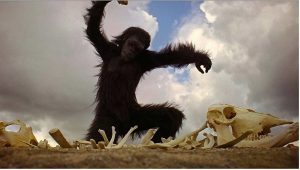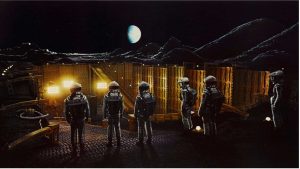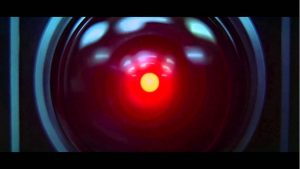2001: A Space Odyssey
The film undergoes several variations of Todorov’s theory in each of the four narrative sections, or perhaps ‘movements,’ of the film. The narrative is primarily linear; however, between each section, there are profuse time differences (flash-forwards), with each section representing a distinct stage in humanity’s evolution: humanity is predestined to rule the Earth, adapts to living in space, creates consciousness and then finally is reborn as the ‘Star Child’.
In ‘THE DAWN OF MAN’ sequence, a relatively peaceful equilibrium is established between the ape tribe and their surroundings. The disruption occurs when a rival tribe presents competition for a watering hole: realised as they begin screeching and howling at one another. The repair of the disruption occurs when one hominid (‘Moonwatcher’ acted by Daniel Richter) uses their newfound knowledge of weapons from the monolith to kill a rival ape with a bone, which scares the contestant band away, and we assume that a new equilibrium is reached. A graphic match cut connects the path of the bone to an orbiting nuclear satellite.

‘Moonwatcher’ discovering using the bone as a weapon
The second, unnamed part, opens with a clear equilibrium: a cosmic ballet between the heavens and the larger, slower, and more precise tools of humanity (namely, the shuttle and Space Station 5, a von Braun wheel or rotating wheel space station) set to Johann Strauss II’s ‘The Blue Danube’. A disruption occurs during Dr. Heywood Floyd’s, Chairperson of the United States National Council of Astronautics’, exchange of pleasantries with some Russian scientists, whereat we discover that there are rumours, and likely a deeper conspiracy, surrounding the Clavius Base. This is confirmed (the disruption recognised) when Dr. Floyd gives a briefing about the need for absolute secrecy surrounding a newly made discovery. The disruption is repaired when Floyd and a select team investigate an identical monolith; when the sun aligns with the monolith and is illuminated, it emits a high-frequency signal.

Dr. Heywood Floyd and the select team investigating the second monolith
In the ‘JUPITER MISSION / 18 MONTHS LATER’ sequence, a state of equilibrium is reached between humanity and technology: the crew and ‘HAL,’ a HAL 9000 series computer. This equilibrium is disrupted when the crewmembers aboard the United States spacecraft, Discovery One, begin to start having doubts about HAL’s intentions, and it reaches its climax when HAL silently disconnects the life support for the other crew members. The scene where HAL refuses to admit Dr. David Bowman, a crewmember, onboard the Discovery One is equivalent to the third stage of Todorov’s theory: the recognition of the disruption. The scene I have chosen to analyse is from this narrative section and is equivalent to the fourth stage of Todorov’s theory: the attempt to repair the disruption. Bowman tries to reason with HAL, but HAL knows that the crew not in suspended animation, Bowman and the recently deceased Dr. Frank Poole, were conspiring against them. Bowman gives up trying to reason with HAL: instead, focusing on disconnecting HAL without any remorse. After these events, Bowman, alone on the craft, signals the reestablishment of the new equilibrium.

HAL’s all-seeing ‘eye’: a Nikon 8mm f/8 lens.
In the final sequence, ‘JUPITER / AND BEYOND THE INFINITE’, Bowman investigates a third monolith orbiting a planet. As the monolith aligns with the surrounding planets, Bowman is engulfed by the psychedelic ‘Star Gate’. The pod appears in a sparingly furnished neoclassical room, lit by the luminescent floor, making it difficult to get consistent bearings. It is impossible to say if and when the equilibrium is disrupted in this jarring scene, as an equilibrium never has any time to be established; partly due to the latter and partly since, several times, Bowman sees an older version of himself and then becomes that self.

The ‘Star Gate’ sequence
![Film Analysis (2001: A Space Odyssey | Goodfellas) [Part 2]](https://joestudios.co.uk/wp-content/uploads/2021/04/DSCF0361-Optimised.jpg)